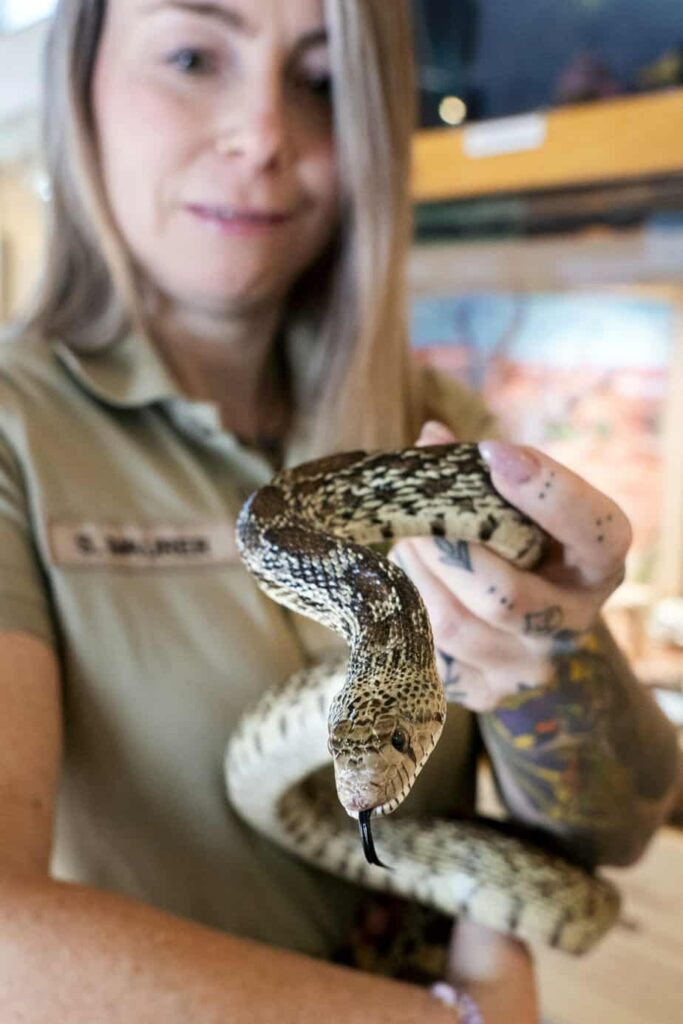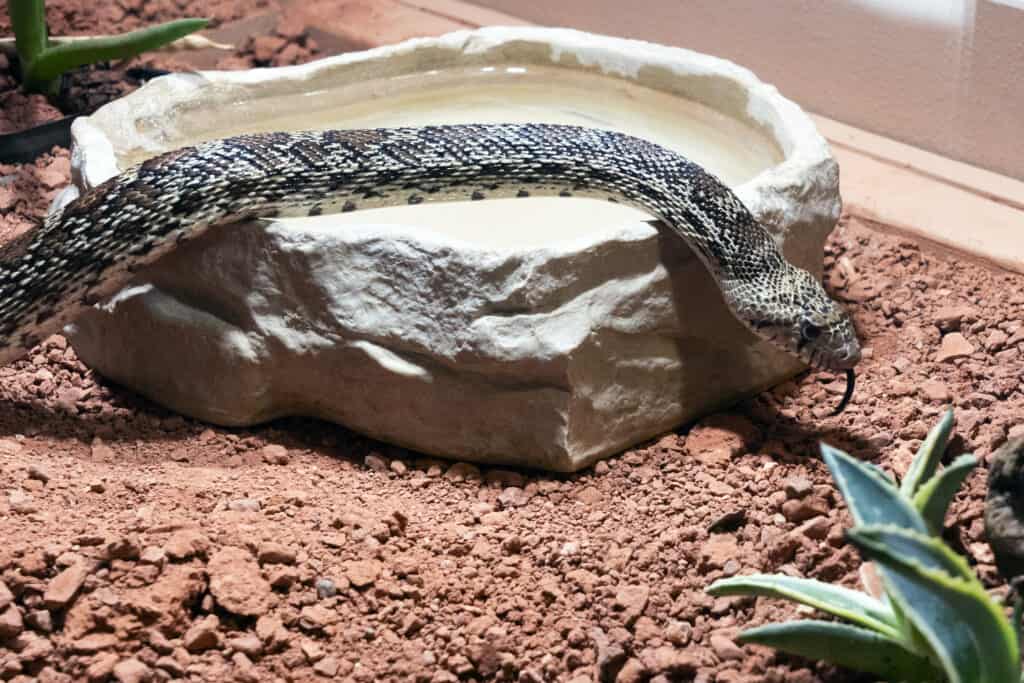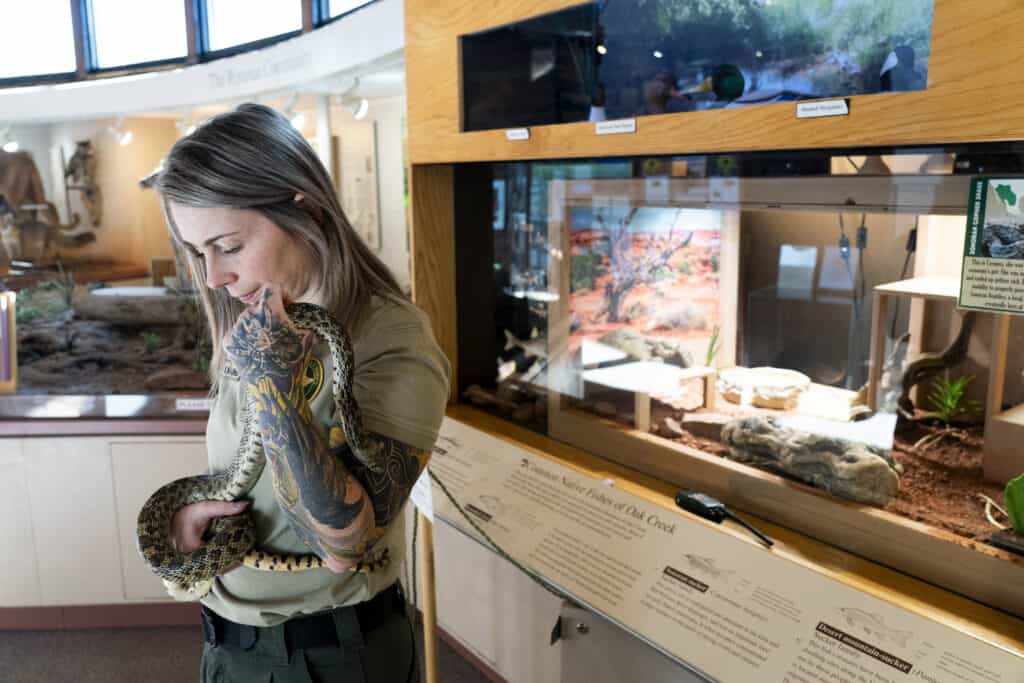Red Rock State Park has a new scaly face greeting people in the visitor center as of Sunday, Oct. 29.
Cosmos, a Sonoran gopher snake in poor health that was acquired by the local nonprofit Sonoran Reptiles, is now an ambassador animal on permanent display at the park with the plan for the adult — probably female — snake to become a part of the park’s educational programming.
“I’m a big reptile and plant person. She’s named after a flower in the [sunflower] family,” Arizona State Parks and Trails ranger Sharon Maurer said. “I am excited to have a snake for the park and I’m very passionate about educating people about venomous versus nonvenomous snakes. Because I know one reaction that many people have when they see a snake is they’re scared and they want to kill it. So I want to try and lessen some of that fear, so gopher snakes don’t get killed.”

The gopher snake is one of the most common snakes found in Arizona and on the North American continent, in large part because they can thrive in a variety of environments from deserts to forests. They have similar coloring and patterning to rattlesnakes, meaning that they are sometimes misidentified as rattlesnakes. Gopher snakes have round pupils and lack the rattlesnake’s distinctive rattle and spade-shaped head. They can grow to be up to nine feet long, but four feet is a more frequent size.
“They’ll puff up their cheeks and turn their head like an arrow shape to mimic the shape of [a] rattlesnake’s head,” Sonoran Reptiles executive director Brett Smith said. “They’ll start shaking their tail and rattling it and they’ll start hissing and the hissing sounds like a rattlesnake rattle.”
“Cosmos was originally taken from the wild to be someone’s pet. She ended up getting sick.

Because the owner could not properly care for her, they surrendered her to Sonoran Reptiles,” park staff posted on Facebook.
“We’re a nonprofit organization based in the Sedona-Verde Valley area,” Smith said. “We don’t have a physical location, but our board is all throughout the area. We do rescue, we take in animals, both native and non-native animals, and we do a lot of education.”
When they received Cosmos, she was suffering from a respiratory disease and an unspecified parasitic infection along with malnourishment. “[Her former owners] eventually noticed that their animals were deteriorating, and they couldn’t afford the vet bills,” Smith said later, explaining why those conditions also preclude Cosmos from being returned to the wild.
“[She’] been in captivity for quite a few years now,” Smith said. “It’s hard to say [if she] will be able to hunt on [her] own again because she acts like a tame snake. She doesn’t really hunt for [her] food, she kind of grabs it gently and doesn’t grab it as if she’s hunting anything … Because of its illnesses, there’s a risk when you release a captive animal into the wild, that it’s going to spread captive-borne diseases or bacteria into wild populations.”
https://www.facebook.com/plugins/post.php?href=https%3A%2F%2Fwww.facebook.com%2Fredrockstatepark%2Fposts%2F733560788811011&show_text=true&width=500
Sonoran Reptiles will remain the owner of the snake and hold the required educational permits through the Arizona Game and Fish Department. The park will be responsible for Cosmos’ care and feeding; however, Sonoran Reptiles will provide technical and health care support as needed.

Smith added that part of the message of Cosmos’ story is not to collect snakes from the wild.
“It’s never a good idea to take an animal from the wild, especially if you don’t have any knowledge on how to take care of them,” he said.
Sonoran Reptiles has received several native species that it has been unable to release into the wild that are now in educational programs.
“If it’s going to live in captivity, it’s nice to have it be able to educate people, and spread knowledge and understanding about the animals,” Smith said. “It’s a cool way to get people interested in native wildlife by seeing something up close and experiencing it. [Which] gets people more excited. But it also opens up a window for them at the park to teach people about the difference between nonvenomous snakes that we have here and venomous snakes, and why you really shouldn’t mess with both.”
However, it will be a while before visitors will be able to hold Cosmos.
“I have to get comfortable with her and she has to get comfortable with me before I can start doing interpretive programs with her and I have to make sure that she’s going to be okay with me holding her out in front of people,” Maurer said.



